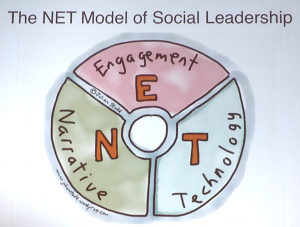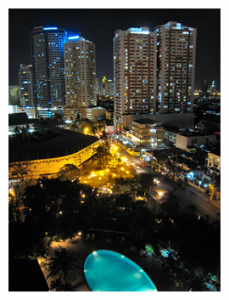Mobile Learning Week
17th – 21st February, 2014
Paris, France

The Eiffel Tower across the Seine, Paris. Photo by Mark Pegrum, 2014. May be reused under CC BY 3.0 licence.
The third UNESCO Mobile Learning Week brought together a global spread of views and insights into mobile learning from a variety of locations, institutions and projects – making Paris the centre of the mobile learning world for a whole week. It began with a series of interactive workshops on Monday, followed by the Mobile Learning Symposium on Tuesday and Wednesday, which was opened by the Director-General of UNESCO, Ms. Irina Bokova.
In the first plenary, 21st Century Learning by design, Chen Keen Tan from Crescent Girls’ School in Singapore spoke about the role of technology in connecting people to each other, to ideas, and to innovation, and empowering young people to do more than to consume – namely to create. Technology, she suggested, promises personalisation, empowerment, anywhere anytime learning, and blended learning. But, she went on to say, the promise is not the problem – the problem is how to go about reform. We often underestimate implementation, impose it in a top-down way, and have insufficient leadership capacity building. This leads to a vision/reality disconnect. Teachers have to deal with the daily realities of classrooms and the concerns, constraints and challenges of teaching. We need to show teachers how to get from the promise to the expected student outcomes. Often there are one or two innovative teachers in every school, but the challenge is to empower all teachers in all schools to use technology effectively. Effective professional development involves active practice and collaboration. She recommended the use of the 21CLD framework, which identifies six dimensions for 21st century learning, and can be used by teachers when they are designing learning experiences for their students. Technology, she said, comes in at the end of the design process, not at the start. Ultimately, we should end with the promise of technology, which comes in naturally to support learning in the classroom. Elements that should change in 21st century design include:
- Student engagement in knowledge building;
- Student ownership of learning;
- Student control vs teacher control (this, she suggested, is a kind of teacher ‘remote control’ – the students feel in control, but actually the teacher is in control through the design process);
- Student empowerment.
In the second plenary, Mobiles for teacher development: Findings from UNESCO field projects in Mexico, Nigeria, Pakistan and Senegal, David Atchoarena from UNESCO spoke about mobile phone-based teacher training projects in these four countries. In Mexico, the focus was on enhancing the teaching practice of primary school Spanish language teachers working with students who speak an indigenous language at home – the approach involved the use of the Nokia Education Delivery (NED) platform and a mobile blog, where teachers shared videos of their lessons. In Nigeria, the focus was on supporting the pedagogical practice and content knowledge of primary school English language teachers – the approach involved the Nokia Life+ platform, where teachers received weekly tips. In Pakistan, the focus was on developing the professional practice of female early childhood education teachers working in rural areas – the approach involved the NED platform, where teachers received videos along with multiple choice questions. In Senegal, the focus was on improving the teaching of science and maths in primary schools – the approach involved the Nokia MoMath platform along with a Moodle-based administration platform; lessons designed by teachers were checked, then uploaded to the MoMath platform. A key finding across these projects was that in a resource-scarce setting, mobile enhances teachers’ access to relevant teaching content and develops their content knowledge. Another finding was that as an easier-to-use device, mobiles remove the barrier to teachers’ ICT skill development. It was also found that students are ready for the next generation of learning, while teachers and principals are more hesitant.
Lessons learnt included: the difficulty of initial teacher training should be toned down and its duration prolonged; ongoing support needs to be planned in advance and mobiles should be used for regular coaching; content development should not be under-invested and the development strategy should be assessed; large-screen phones are appropriate for teachers (and projection is necessary for students); and teachers should be supported in connecting through multiple local networks.
In his talk, Faculty development, 2019: A futurism exercise, Kyle Dickson spoke about getting faculty to see themselves as digital creators and storytellers, rather than starting with the technological tools. He described a training programme at Abilene Christian University where faculty learned about digital photography and digital storytelling (which, at its essence, is about media literacy). This kind of training can be entirely delivered on mobile devices in the field. He concluded by saying that great storytellers have something to teach us about faculty development – it’s not just about learning about the technology as fast as possible, but intrinsically motivating participation through the focus on narrative. Like great storytelling, education takes time, stress and tension, and is less about the student replicating the teacher than about finding his or her own voice.
In his talk, The culturally-aware curricular and technology intervention (CACTI) model, George Saltsmann discussed the importance of sensitivity when transplanting best practices with technology from one culture into another. It is important that educators do not inadvertently destroy the cultures they are setting out to assist and protect. UNESCO promotes the idea of ‘intangible cultural heritage’, which it is essential to safeguard. What does it mean when we bring the internet, with the dominance of English, to Africa through mobile devices? We need to ask questions about the local culture, what best design practices are, what existing local resources can be used, how we can work collaboratively and give all partners a voice, how we can adapt plans based on iterative feedback and partnership, how we can evaluate the effectiveness of interventions, and how we can share successes with all stakeholders.
In their talk, Using SMS to support the professional development of school principals/headteachers in Ghana, Louis Major and Sue Swaffield spoke about the Leadership for Learning (LfL) Ghana programme, which has been running since 2009, and aims to improve school principals’ leadership capacity in order to enhance the quality of learning and teaching. SMS messaging has been identified as a way to sustain engagement and maintain fidelity to the LfL principles. It will take the form of group messaging, initially with 10 SMS groups, each consisting of 10 headteachers and moderated by a facilitator. Research will be conducted to reveal the effectiveness and implications of the use of this group SMS model. It could potentially be scaled up in the future, or used in other contexts, if it is successful. Sustainability will be a key issue, and will be considered from the outset.
In her talk, Mobilizing the middle kingdom: Teacher-led mobile learning in a Chinese high school, Na Liu spoke about mobile learning at Beijing Royal School (BRS). Mobile learning allows more collaborative work and more connections between subjects; DropBox serves as a hand-in folder, while WeChat allows constant teacher-student contact. Student learning has become more personalised, with students being able to study anywhere, and they have a sense of belonging to a global community of digital learners as they collaborate with students in South Africa. The school takes a flipped approach, with students able to download texts and videos before class, allowing more time in class for discussion and group work. All in all, mobile learning has been very empowering for students, who some of the time can teach each other as well as the teachers. Quantifiable successes have included the fact that BRS mobile learning students’ SAT reading and writing scores have gone up, and they are spending more than an hour a week reading in English.
In the plenary panel discussion, Teachers and mobile learning: Voices from the ground, moderated by Mar Camacho (Brazil), teachers from four countries – Na Liu (China), Nassirou Oumarou Maman (Niger), Erkan Taskaya (Turkey) and Emelie Ohm (Sweden) – discussed the use of mobile technologies in their varying locations, providing a range of insights into the potential of m-learning around the world.
On the second morning of the Symposium, in a plenary paper entitled Mobiles for reading: Findings from two soon to be published UNESCO reports, Mark West outlined recent research on mobile readers. There are still 774 million illiterates in the world, he noted. The key findings about the use of mobile readers included:
- Most mobile readers are male;
- Women spend far more time reading on mobiles than men;
- Mobile reading positively impacts children (one in three survey participants said they read to children, so mobile reading has a ripple effect; many mobile readers are in fact teachers);
- Mobile reading appeals to (and can benefit) neo-literate and semi-literate adults and adolescents;
- Among the core barriers to mobile reading are a lack of relevant content and poor connectivity.
In the presentation, Lessons learned from an open multimedia professional development programme to support interactive teaching using mobile technology in sub-Saharan Africa, Sara Hennessy and Bjoern Hassler spoke about teacher development in Zambia. It is important, they suggested, to focus on three key elements: interactive pedagogy, open educational resources, and digital technology. They noted that connected/disconnected is a false dichotomy, since the reality is variable connectivity everywhere, whether in Europe or Africa.
In my own talk, How can we balance affordability and affordances in the design of mobile pedagogy?, I discussed three types of mobile learning:
- when the devices are mobile;
- when the devices and the learners are both mobile;
- when the devices, the learners and the learning experience are all mobile;
followed by three agendas for mobile learning:
- transforming teaching & learning;
- developing 21st century skills/digital literacies;
- social justice.
I argued that depending on the type of mobile learning, and the agenda for mobile learning, there will be different levels of affordability of the devices, connected to different levels of affordances for learning. For the most part, affordability and affordances are inversely related. Designing the optimal kind of mobile learning for our students in our own context always involves carefully balancing up affordability and affordances.
In the talk, The digital learning transition MOOC for educators: Exploring a personalized and scalable approach to professional development (co-authored with Mary Ann Wolf), Glenn Kleinmann argued that personalised, accessible, effective, scalable PD is necessary for educators, and asked whether educational MOOCs (termed MOOC-Eds) can be used for this purpose. He described such a MOOC-Ed which is oriented around the principles of:
- self-directed learning;
- peer-supported learning;
- case studies and authentic projects;
- blended learning.
In the paper, Changing the role of teachers by integrating mobile technology in a rural school in Zimbabwe: A reflection in light of UNESCO policy guidelines, Urs Grohbiel and Christoph Pimmer discussed an iPad project in a secondary school in rural Zimbabwe, designed to address a lack of teaching materials and qualified teachers. They examined the project in light of UNESCO’s mobile policy guidelines, which they suggested are a very useful framework for thinking about the implementation of mobile learning projects.
In her paper, The mEducation Alliance: Scaling technology in education investments through international collaboration, Cecilia Martins indicated that investment in technologies for education must involve: learning from our failures, considering the impact on learning outcomes, and considering whether it is cost-effective, sustainable and replicable. The mEducation Alliance brings together a wide range of organisations working in the educational technology space. It is important that different organisations work together and learn from each other’s successes and mistakes, but that projects can still be tailored to local conditions and contexts. She went on to discuss key elements of a collective agenda:
- Community engagement;
- Respectful partnership;
- Sharing challenges and opportunities;
- Access to quality education for all;
- Strategic rationale for policy makers;
- Promoting social inclusion for economic growth.
mAlliance activity highlights include convening multi-stakeholder partnerships, catalysing research, catalysing partnerships, and sharing knowledge and learning. Future aims include setting up an ICT4E Evaluation Fund to conduct rigorous evaluation of projects.
In the paper Promoting 21st century citizenship for and with ICT: Current initiatives from Bangkok (co-authored with Ichiro Miyazawa), Jonghwi Park outlined two important initiatives from UNESCO Bangkok, which serves 49 countries in the Asian region. The first initiative involves fostering digital citizenship through safe and responsible use of ICTs, and the second takes the form of a mobile app for disaster risk reduction education. There is a big digital divide among the ASEAN countries when it comes to computers, but not so much when it comes to mobile devices. Opportunities and risks for children go hand-in-hand. Thus it is important to educate children about the dangers of overuse of ICTs; risks inlcude cyberbullying, health/addiction, unethical use, and so on. Among ASEAN countries, only Singapore and Malaysia have systematic programmes in this area, hence the need for the first initiative on fostering digital citizenship. The second initiative has produced ‘Sai Fah’ (‘The Flood Fighter’ in Thai), a mobile app on flood risk reduction, which is available to download. It takes the form of a game with before/during/after flood stages.
In the final plenary session of the Mobile Learning Symposium, entitled Emerging trends and new technology, an international panel talked about current and future developments in mobile education. The feeling was that education is already being transformed by new technologies, but that there is much more to come. It was suggested, both by panel and audience members, that there is a need for more teacher training, within a more holistic approach drawing in all stakeholders. At the end, panel members were asked to identify one or two key trends of coming years; the themes mentioned included: increasing use of mobile devices in combination with other technologies; social learning; comprehensive pre-service and in-service professional development for teachers; and necessary policies for guiding electronic content and analytics. The symposium was then closed by Francesc Pedro, Chief of Section, UNESCO.
The Mobile Learning Week concluded on the Friday with a Research Track chaired by John Traxler, where a series of moderated panels addressed key issues in mobile learning research:
- Pilots, Projects and their Data (moderated by myself);
- The Role of Research and of Researchers (moderated by David Parsons);
- From Evidence to Priorities (moderated by Helen Keegan);
- Participants, Stakeholders and Ethics (moderated by Alex Tyers);
- Research-informed Research Priorities (moderated by Nicole Kendall);
- Programmes, Monitoring and Evaluation (moderated by Dan Wagner);
- Dissemination, Publication and Symposia (moderated by Purna Shrestha).
Unfortunately I had to skip the final two panels in order to get to the airport in time for my flight back to Australia, but I’m looking forward to catching up on what I missed in the summary publication which will appear in due course.
While it is difficult to pull out a clear set of key themes from reports of so many diverse projects and practices over the course of a whole week, it’s clear that there is a great deal of vitality in mobile learning around the world. Mobile teaching and learning practices are continuing to develop rapidly, along with an emerging body of research disseminating findings about successes and challenges encountered to date, and sketching out elements of best practice. UNESCO fulfils a very important role in providing a unified global platform for beginning to integrate our insights into mobile learning.





